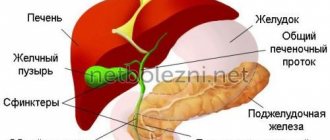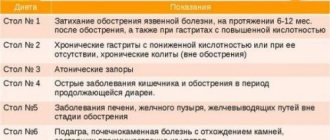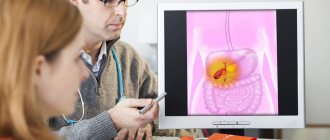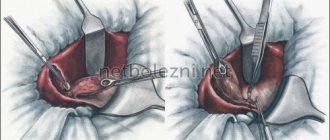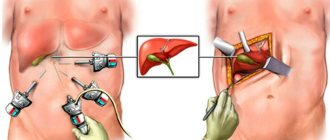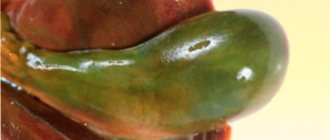Today, surgery to remove the gallbladder is not uncommon. This is no longer a death sentence; a person can continue to lead a full life. In this article, you will learn how to eat properly after surgery to avoid complications, get advice from gastroenterologists on diet, and learn dangerous signs that, if detected, should promptly consult a doctor.
If you follow all the recommendations and eat right, you can live a long time and without problems in this area of health, even after surgery to remove the gallbladder. However, if you do not follow doctors’ recommendations and do not monitor your health, there is a high risk of complications and the formation of new stones in the bile ducts.
What happens after gallbladder removal?
This organ is classified as non-vital. However, removing the gallbladder is not a solution to the problem of stone formation. Most patients immediately after having this organ removed experience symptoms:
- pain in the lumbar region of a pulling nature;
- heaviness in the side;
- urge to vomit;
- a feeling of bitterness in the mouth;
- change in color of feces and urine.
If these symptoms reappear some time after the operation, it means that a complication is developing - postcholecystectomy syndrome (PCES). Therefore, if such signs are detected again, you need to contact a gastroenterologist.
If vomiting, a sharp increase in temperature, or stabbing pain occurs, you urgently need to call an ambulance - a second operation may be required.
Even if you do not have any problems after surgery, be sure to undergo regular examination by a doctor (1-2 times a year) to prevent the appearance of a new stone in the duct and repeated operations. It is necessary to perform gymnastics, carry out drug therapy prescribed by a doctor and follow a certain diet.
Approximate food menu
It should be noted that the menu described below can be used no earlier than 2 months after the operation. Until this point, restrictions on food consumption must be stricter. It is also necessary to take into account that the diet after excision of the gallbladder should be long-term; it is only possible to alternate between dishes that are allowed for consumption and those made according to special recipes.
8:00 - first breakfast:
- a piece of day-old white bread with apple jam - 120 g;
- buckwheat - 160 gr.;
- weakly brewed tea - 300 gr.
11:00 - second breakfast:
- carrot-apple juice with pulp - 300 g;
- cottage cheese - 170 gr.
14:00 - lunch:
- boiled chicken - 160 gr.;
- potato soup with vegetable broth (without hot herbs and spices, you can add a few bay leaves to the soup after cooking) - 260–320 g;
- bread - 160 gr.;
- as a side dish, zucchini puree - 130 g;
- weakly brewed tea - 300 gr.
17:00 - afternoon snack:
- bread - 120 gr.;
- mashed potatoes - 220 gr.;
- jelly - 220 gr.;
- biscuits - up to 5 pieces.
20:00 - dinner:
- kefir - 300 gr.;
- baked apples - 2 pieces;
- casserole or curd pudding - 220 gr.
Twice a week in the diet, for lunch, meat dishes should be replaced with boiled fish. The amount of food consumed can be varied within certain limits, taking into account a person’s weight, his daily physical activity and lifestyle. Also, you should not take various protein products at one time (for example, dairy and meat or dairy and fish) - this can lead to increased gas formation in the intestines and bloating.
"Our" fruits. Allowed and prohibited
Baked apples are not only tasty, but also healthy, especially for the intestines.
Most local fruits are acceptable for consumption, just in different forms. It depends on how much time has passed since the operation.
| Apples | They contain many important macro- and microelements - primarily iron. But in the near future after surgery you cannot eat them fresh - only baked or in the form of compote. 13-15 days after the operation, you can add raw apples, but you cannot drink the juice from this fruit! Or dilute at least 1:1. |
| Pears | An important product in the postoperative period. Helps restore the pancreas. It is permissible to use in any form, but in small quantities. |
| Plums | These fruits contain many useful elements and fiber. But their use is prohibited. You will have to suffer for at least 3 months. |
| Apricots, peaches | Similarly to apples, for two weeks after surgery, eat them in the form of jelly, compotes, etc., then in any form. |
It is recommended to peel the fruit first. You should also not eat fruits that are too sour or too sweet - choose mid-ripening ones. It is recommended to regularly eat apricot kernels, consuming 6-8 kernels per day, which will greatly reduce the risk of malignant neoplasms of the bile ducts.
Tropical fruits. Allowed and prohibited
Pineapple contains the enzyme bromelain, which breaks down animal protein. Even completely healthy people are advised to eat it in small quantities and with caution.
“Overseas” fruits are no less healthy than “ours”. They contain many useful elements and vitamins. But they are brought from afar and, most likely, preservatives are used for longer storage - therefore it is strictly forbidden to eat tropical fruits purchased from unverified suppliers. There are many that are not allowed to be eaten after surgery at all:
| Bananas | An incredibly healthy product, it is approved for use even with inflammation of the bile ducts, and can be eaten in any form. It may cause bloating, so you should not take more than 1 piece per day. |
| Citrus | Like any other sour product, it is prohibited for consumption in the coming months. |
| Pomegranate | Along with citrus fruits, it is included in the list of prohibited foods after surgery. |
| Persimmon | Strictly not recommended due to “viscosity”. |
| A pineapple | Despite its apparent sweetness, it contains a large amount of acid, which is unacceptable for entry into the digestive system. This fruit is also prohibited for consumption. |
Thus, it is necessary to exclude all tropical fruits from the diet, except bananas, and gradually introduce them into the diet after 3 months.
Second week menu
If the operation proceeds without complications and the rehabilitation process proceeds as standard, a natural transition to diet 5a occurs. The basic principle of the diet is a minimum load on the digestive tract (chemical, mechanical). Everything is steamed or boiled. The menu includes:
- Boiled and steamed protein products – meat, fish, etc.
- Dietary soups.
- Puddings.
- Easy casseroles.
- Stewed vegetable dishes and mashed potatoes.
- Liquid porridge (semolina is excluded). You can cook porridge in water, or you can dilute the liquid base by half with milk.
- Fruit jelly.
- Vegetable oil for dressing in small quantities.
- Low-fat dairy products.
- White bread, yesterday's bread.
If, in the presence of this diet, you still experience unpleasant symptoms of difficult digestion (gas, diarrhea, pain in the right hypochondrium), you need to reconsider its individual components or switch to the 5sch regimen, which is more gentle on the body.
Dietary nutrition for weakened patients in the second week
For the first meal: a small portion of semolina cooked in milk, steamed egg whites in the form of an omelet (about 100 g). Tea is allowed as a drink.
Second: rosehip broth, fresh cottage cheese without additives (neutral).
3rd: pureed vegetable soup with the addition of cereals (for example, oatmeal) - a small portion or half of the main one, tender boiled meat, carrot puree, fruit jelly for dessert.
4th: oven-cooked apples.
5th: mashed potatoes with boiled fish - a small portion. weak tea.
Final meal: kefir or fruit jelly.
You should not use seasonings that provoke the secretion of bile, as well as any smoked foods, extremely hot and cold dishes.
Berries. Allowed and prohibited
Berries are even more beneficial for patients who have undergone surgery than fruits. They can be stored frozen for a long time even without adding preservatives. Certain conditions and nuances of their use:
| Cherry | A very acidic product, therefore it can be eaten only 6-8 days after surgical treatment in the form of compote, jelly and jelly. |
| Cherries | Contains many useful microelements, including manganese, copper, zinc, which cannot be replaced by anything in the functioning of the biliary system. You can start consuming it raw 13-15 days after surgery. |
| Raspberries | Improves digestion; you can start eating in small doses 13-15 days after surgery. |
| Currant | The berry is very sour, but after 6-8 days it can be eaten in the form of compote. |
| Strawberry | Can be eaten 13-15 days after cholecystectomy, if ripe. |
| Grape | Due to bloating in the stomach after consumption, this berry should not be eaten for 2 months after surgery. |
| Watermelon and melon | Very healthy berries, recommended for consumption immediately after cholecystectomy. |
Learn about the beneficial properties of watermelon from the video:
When choosing berries, preference should be given to local ones, produced in neighboring regions - and the risk that they were treated with preservatives or exposed to chemicals is very small. The ratio of berry juice and water in the compote should be 1:3 (or the percentage of berries is less).
Vegetables. Allowed and prohibited
There are fewer prohibited vegetables to eat after surgery
Almost all vegetables, unlike fruits, are recommended to be consumed in any form - both fresh and in the form of any other dishes. They shouldn't be too sharp. Vegetables that are recommended for consumption:
- carrot;
- eggplant;
- beet;
- cauliflower and white cabbage;
- cucumbers;
- potatoes;
- beans;
- peas;
- pumpkin
You need to be careful with the last two products, as they cause flatulence.
Vegetables that should not be eaten:
- turnip;
- garlic;
- radish;
- tomato;
- onion;
- Bell pepper;
- eggplants (blue - in the desired quantity, white - in very small volumes);
- spinach, sorrel.
After surgery, a person does not need to eat only plant foods. It is also necessary to consume food of animal origin - it contains substances important for life. The patient needs to eat 400-450 grams of vegetables and 200-225 grams of fruits per day.
The amount of food consumed should increase gradually over time after cholecystectomy. The first day after the operation, it is completely prohibited not only to eat, but also to drink.
Preventing complications
With the help of nutrition, you can prevent some complications and restore impaired functions. If the reason for cholecystectomy was the presence of stones in the bladder, complications such as duodenitis, dyskinesia, cholangitis, and sphincter of Oddi insufficiency may develop.
In order to correct the condition, all foods that contribute to increased bile secretion are removed from the diet:
- any fats, including vegetable fats;
- coarse fiber;
- onion, garlic, radish;
- fatty meat and fish;
- soups with meat, fish and mushrooms.
It is also necessary to reduce or eliminate salt
and
drink less fluid
. Products harmful to the pancreas are excluded - everything that is rich in fiber, contains uric acid and extractives (offal, some types of fish, seafood).
The benefits of greenery
The most important beneficial properties of parsley: prevent cancer, reduce blood sugar and cholesterol, protect the lungs and heart.
Any herb or greens can and should be taken into food by the patient in any quantity. According to folk medicine, they help cleanse the body and, in particular, the liver of toxins. It is recommended to consume parsley and dill, because this is a measure to prevent the formation of new stones in the bile ducts. In addition, greens improve digestion.
Parsley is especially useful - it contains many micro- and macroelements, beta-carotene and a large number of vitamins, which improves immunity and reduces the risk of malignant tumors, so those who have undergone an operation such as cholecystectomy should add more of this greenery to their diet.
Eating Tips
Due to poor nutrition after cholecystectomy, many patients complain of a variety of problems. Constipation, abdominal pain, or even chronic digestive diseases may develop. The main thing in nutrition after surgery is to eat “little by little.” 5-6 times a day. The same principle applies to drinking. To avoid health problems, you must:
- Exclude rice and BP flakes from the diet.
- Add milk products (necessarily fresh).
- Add a lot of fiber - vegetables, fruits, herbs.
- Wheat bran.
- Alcohol is contraindicated for 2 months after surgery. Further, in rare cases, no more than 300 ml of dry wine per day.
- You should not eat a lot of porridge and soups.
- Carbonated drinks are strictly prohibited.
- Cook all food with a minimum amount of salt, fat and oil.
- You need to drink 2 liters of liquid per day.
- Dishes should be cut into small pieces.
Watch the video for nutritional tips for those recovering after surgery:
Breakfast items
Curd paste
What you will need:
- Cottage cheese maximum fat content 9% – 100 g
- Sour cream or cream - 1 tbsp. l.
- Sugar - 1 tbsp. l.
Mix all products thoroughly. Lazy housewives can pass the mass through a sieve. Variations of this recipe - add salt to taste, finely chopped herbs - dill, parsley - and you have a salty curd paste recipe. Spread the paste on yesterday's piece of bread, put a piece of boiled chicken or beef on top - and you have a complete breakfast, snack or afternoon snack on your table.
Semolina
Ingredients:
- Semolina – 2 tbsp. l.
- Milk – 3/4 cup
- Water – 1/4 cup
- Butter – 1 tsp.
- Sugar to taste, but not more than 1 tbsp. l.
Place milk, water, salt, sugar in a saucepan, bring to a boil and add semolina. Cook until thickened with constant stirring. Add butter and decorate the porridge with non-acidic berries or pieces of fruit. If you want an unusual semolina porridge, try adding fresh carrots during cooking. The root vegetable is washed, peeled and grated on a very fine grater. The porridge is cooked using standard technology; 3 minutes before the end of cooking, add carrots to the pan, stir and let it boil. Season the finished porridge with oil.
White omelette
Ingredients:
- 3 egg whites
- Milk – 30 g
- Salt, butter
Separate the whites and beat them with milk and salt. Ideally, this omelette is cooked in a steam bath in a double boiler. What to do if you don’t have such a kitchen gadget? Grease a non-stick frying pan with oil and place on fire. Pour the whipped egg whites into a heated frying pan, cover with a lid and simmer over low heat until cooked. Serve with vegetable salad or sour cream sauce.
Lazy dumplings
You will need:
- Cottage cheese – 1 package or 250 g
- Flour – 2 tbsp. l.
- Sugar to taste, but not more than 1 tbsp. l.
- Egg – 1 pc.
- Salt
Mix all products thoroughly and form dumplings. Boil in boiling water. Serve with sour cream or berry sauce.
